贝加尔湖英文小介绍
贝加尔湖英语作文高中
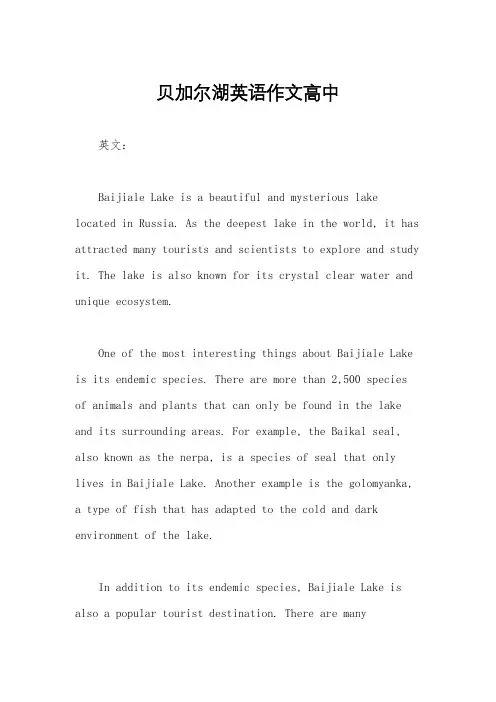
贝加尔湖英语作文高中英文:Baijiale Lake is a beautiful and mysterious lake located in Russia. As the deepest lake in the world, it has attracted many tourists and scientists to explore and study it. The lake is also known for its crystal clear water and unique ecosystem.One of the most interesting things about Baijiale Lake is its endemic species. There are more than 2,500 species of animals and plants that can only be found in the lake and its surrounding areas. For example, the Baikal seal, also known as the nerpa, is a species of seal that only lives in Baijiale Lake. Another example is the golomyanka, a type of fish that has adapted to the cold and dark environment of the lake.In addition to its endemic species, Baijiale Lake is also a popular tourist destination. There are manyactivities that visitors can do, such as hiking, camping, and fishing. One of the most popular attractions is the Circum-Baikal Railway, which offers stunning views of the lake and its surrounding mountains.中文:贝加尔湖是位于俄罗斯的一座美丽而神秘的湖泊。
世界最大的湖泊

世界最大的湖泊湖泊:hupō ,陆地表面洼地积水形成的比较宽广的水域。
现代地质学定义:陆地上洼地积水形成的、水域比较宽广、换流缓慢的水体。
现在由小编为你们介绍世界最大的湖泊,欢迎读者阅读。
世界上最大的湖泊--里海世界上最大的湖泊——里海,位于欧亚大陆之间,它的西南面和南面为高加索山脉和厄尔布尔士山脉的连绵雪峰环绕,其它三面只是坦荡辽阔的平原。
里还是我国的称呼,它的译名应为卡斯皮海,得名于古代居住在高加索东部的一个部落——卡斯皮人。
人们称里海为“海”,不仅是由于它具有一些海的特征,如面积大、水深、常有狂风巨浪、动植物与海洋相近等,而且也由于它过去确实是海的一部分。
大约在几百万年以前,里海是与黑海和地中海相同的,以后由于地壳运动,这里的海陆范围曾多次变化,里海与黑海最后分离成为一个内陆湖泊,距今不过1万1千多年。
在地理学上,这一类湖泊被称为“海迹湖”。
里海简介里海是世界上最大的内陆水体。
它的面积为37.18万平方千米,比德国大,接近日本的面积,北美洲五大湖总面积的1.5倍.里海总面积的五分之二左右在伊朗境内。
其余部分在俄国境内。
这个巨大的湖泊(实际上不是海)全长1225千米。
名叫卡拉博加兹戈尔的大海湾在里海主体之外,低长的沙嘴几乎上把海湾与里海隔离。
冲入海湾的水迅速蒸发。
海湾水深均不足10米,含盐度为35%,相比之下里海主体的含盐度是11.3%,世界大洋为3.5%。
里海地处一巨大的盆地,深达1025米,而北部平坦的湖底只有5米深左右。
伏尔加河接纳北部高地的径流,注入里海,约四分之三的里海水量来自于伏尔加河。
没有河流从里海流出,里海也没有潮汐。
里海水面约低于海平面28.5米。
这低于19世纪初的水面,当时里海水面低于海平面22米。
换句话说,该湖泊正在逐渐失去其水量。
这不是因为气候的缘故,而是由于人类的活动所造成的。
通常供给该湖泊的河水已转为其他用途。
如灌溉等。
已建成的大坝也使流入里海的水量减少。
近些年来俄国政府设想改变某些西伯利亚河流的流路,使它们由现在的向北流淌改为向南流入伏尔加河。
世界神秘湖泊系列——贝加尔湖
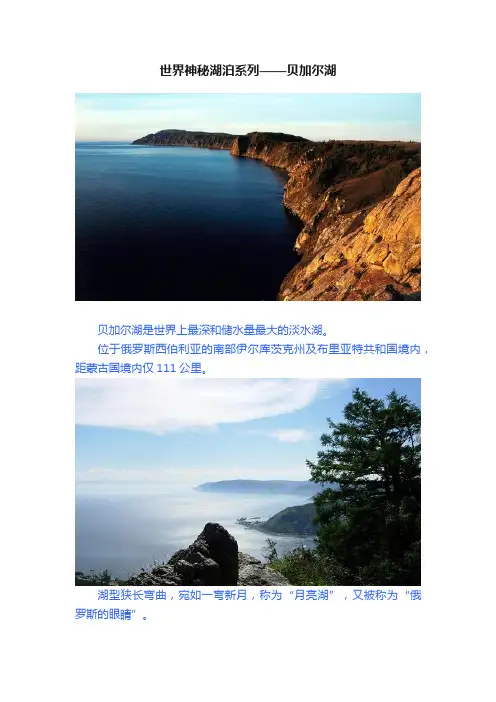
世界神秘湖泊系列——贝加尔湖贝加尔湖是世界上最深和储水量最大的淡水湖。
位于俄罗斯西伯利亚的南部伊尔库茨克州及布里亚特共和国境内,距蒙古国境内仅111公里。
湖型狭长弯曲,宛如一弯新月,称为“月亮湖”,又被称为“俄罗斯的眼睛”。
湖水平均深度730米,最深1637米,湖水储量23000立方千米,是北美五大湖的总储水量,全人类可以依靠贝加尔湖水生存40年。
湖内水生动物1200种,湖的沿岸植物生长茂盛,湖底蕴藏丰富的资源。
湖水面积31500平方千米。
贝加尔湖地区阳光充沛,雨量稀少,冬暖夏凉,有矿泉300多处,是俄罗斯东部地区最大的疗养中心和旅游胜地。
贝加尔湖布里亚特蒙古语:Байгал нуур,拉丁转写:Baygal nuur,俄语:О?зеро Байка?л),面积31,494平方公里,平均深度744 米,最深点1637米,是世界容量最大,最深的淡水湖,被称为“西伯利亚的蓝眼睛”。
位于俄罗斯西伯利亚的南部伊尔库茨克州及布里亚特共和国境内,距蒙古国边界仅111公里,是东亚地区不少民族的发源地。
联合国教科文组织于1996年将贝加尔湖登录为世界遗产。
贝加尔湖贝加尔湖一词来源于古肃慎语(满语)“贝海儿湖”,古代中国史籍称贝加尔湖为瀚海,又称北海,英文“baykal”一词为汉语音译,俄语称之为“baukaji”源出蒙古语,是由“saii”(富饶的)加“kyji”(湖泊)转化而来,意为“富饶的湖泊”,因湖中盛产多种鱼类而得名。
根据布里亚特人的传说,贝加尔湖称为“贝加尔达拉伊”意为“自然的海”。
贝加尔湖最早出现在书面记载中是在公元前110年前,中国汉代的一个官员在其札记中称贝加尔湖为“北海”,这可能是贝加尔湖俄语名称的起源。
关于贝加尔湖名称来源还有一种简单解释:突厥人称贝加尔湖为“富裕之湖”,突厥族语“富裕之湖”逐渐演化成俄语的“贝加尔湖”。
中国汉代称之为“柏海”,元代称之为“菊海”,18世纪初的《异域录》称之为“柏海儿湖”,《大清一统志》称为“白哈儿湖”。
写贝加尔湖英语作文
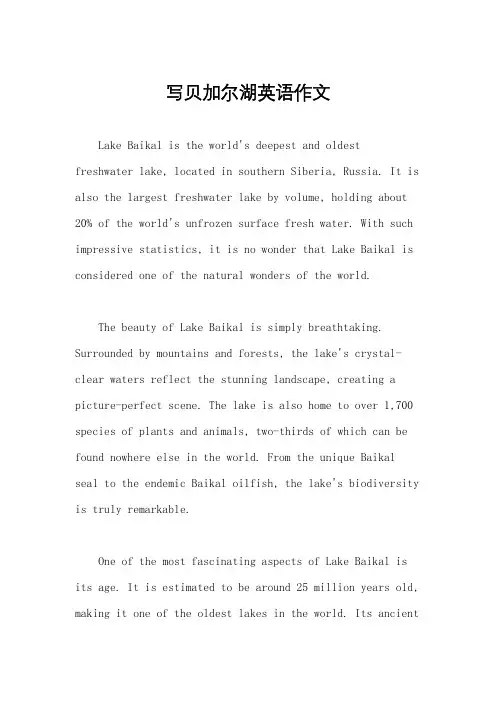
写贝加尔湖英语作文Lake Baikal is the world's deepest and oldest freshwater lake, located in southern Siberia, Russia. It is also the largest freshwater lake by volume, holding about 20% of the world's unfrozen surface fresh water. With such impressive statistics, it is no wonder that Lake Baikal is considered one of the natural wonders of the world.The beauty of Lake Baikal is simply breathtaking. Surrounded by mountains and forests, the lake's crystal-clear waters reflect the stunning landscape, creating a picture-perfect scene. The lake is also home to over 1,700 species of plants and animals, two-thirds of which can be found nowhere else in the world. From the unique Baikal seal to the endemic Baikal oilfish, the lake's biodiversity is truly remarkable.One of the most fascinating aspects of Lake Baikal is its age. It is estimated to be around 25 million years old, making it one of the oldest lakes in the world. Its ancienthistory is evident in the rock formations and geological features found in the area. The lake is also a hotspot for scientific research, attracting scientists from all overthe world who are eager to study its geological and biological wonders.Aside from its natural beauty and scientific importance, Lake Baikal also holds cultural significance. The lake is considered sacred by the indigenous Buryat people, who have inhabited the region for centuries. They believe that the lake has healing powers and often perform rituals and ceremonies on its shores. The Buryat people also have adeep respect for the lake and its surroundings, practicing sustainable fishing and forestry to preserve the delicate ecosystem.Tourism is a major industry in the Lake Baikal region, attracting visitors from all over the world. The lakeoffers a wide range of activities for tourists to enjoy, such as hiking, camping, and boating. In the winter, the lake freezes over, creating a unique opportunity for ice skating and ice fishing. Many tourists also take the famousCircum-Baikal Railway, which offers breathtaking views of the lake and its surrounding landscapes.Despite its popularity, Lake Baikal faces several challenges. Climate change is causing the lake's ice cover to melt earlier each year, disrupting the ecosystem and threatening the survival of some species. Pollution from nearby industries and tourism activities also poses athreat to the lake's delicate balance. Efforts are being made to protect Lake Baikal, such as the establishment of national parks and the implementation of stricter environmental regulations.In conclusion, Lake Baikal is a natural wonder that captivates visitors with its beauty, history, and cultural significance. As one of the oldest and deepest lakes in the world, it holds immense scientific value and is home to a diverse range of plant and animal species. However, it is crucial that we take steps to protect and preserve this unique ecosystem for future generations to enjoy. Only through sustainable practices and environmental awarenesscan we ensure the continued existence of this magnificent natural wonder.。
贝加尔湖畔英语ppt
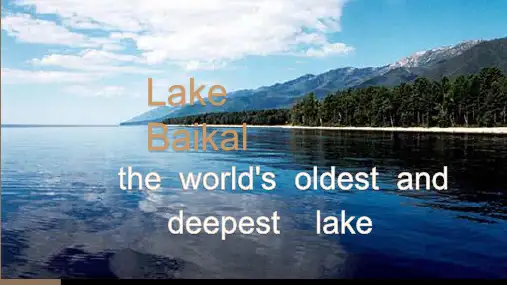
It holds on one-fifth of the world's total freshwater, which is more than the total of all the water in five great lakes; it holds so much fresh
Lake Baikal
Lake Baikal ,which today is located near the center of Asia, is most likely the oldest lake in the world. It began forming 25 million years ago as Asia started splitting apart in series of great faults. The Baikal valley dropped away, eventually filling with water and creating the deepest of the world's lakes.
Lake Baikal is the world's largest and deepest freshwater lake, known as the "blue eyes of Siberia"".
Type strip is bent, like the crescent moon, so it is called "Moon Lake".
Beautiful legend
贝加尔湖英语作文高中
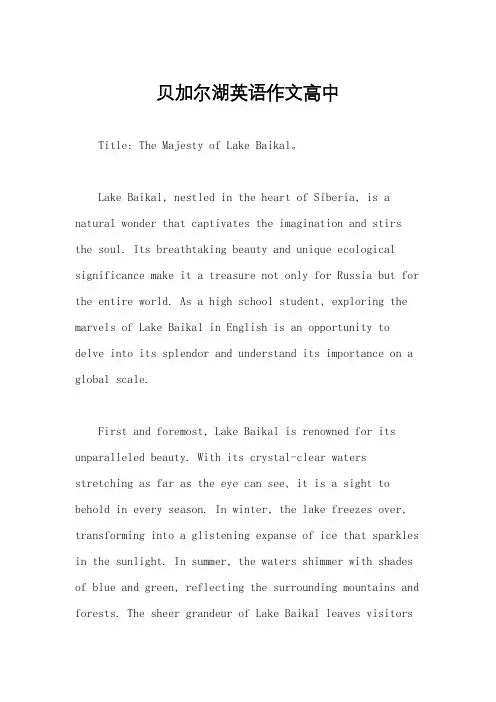
贝加尔湖英语作文高中Title: The Majesty of Lake Baikal。
Lake Baikal, nestled in the heart of Siberia, is a natural wonder that captivates the imagination and stirs the soul. Its breathtaking beauty and unique ecological significance make it a treasure not only for Russia but for the entire world. As a high school student, exploring the marvels of Lake Baikal in English is an opportunity to delve into its splendor and understand its importance on a global scale.First and foremost, Lake Baikal is renowned for its unparalleled beauty. With its crystal-clear waters stretching as far as the eye can see, it is a sight to behold in every season. In winter, the lake freezes over, transforming into a glistening expanse of ice that sparkles in the sunlight. In summer, the waters shimmer with shades of blue and green, reflecting the surrounding mountains and forests. The sheer grandeur of Lake Baikal leaves visitorsin awe of nature's magnificence.Beyond its aesthetic appeal, Lake Baikal boasts remarkable ecological significance. As the deepest and oldest freshwater lake in the world, it is home to a wealth of unique flora and fauna found nowhere else on Earth. The Baikal seal, or nerpa, is one such example, adapted to its icy habitat over millennia. The lake also harbors a diverse array of fish species, including the omul and the golomyanka, each playing a vital role in the lake'sdelicate ecosystem.Furthermore, Lake Baikal serves as a crucial reservoir of freshwater, containing approximately 20% of the world's unfrozen surface freshwater. Its pristine waters are a source of sustenance for surrounding communities and support a thriving fishing industry. Additionally, thelake's purity makes it an invaluable resource forscientific research, offering insights into freshwater ecosystems and climate change.However, Lake Baikal faces numerous threats to itsecological integrity. Pollution from industrial activities, agricultural runoff, and tourism poses a significant risk to the lake's fragile ecosystem. Climate change exacerbates these challenges, leading to rising temperatures, altered precipitation patterns, and shrinking ice cover. These threats underscore the importance of conservation efforts to preserve Lake Baikal for future generations.Fortunately, there are initiatives underway to protect and preserve Lake Baikal's pristine environment. National parks and protected areas surrounding the lake safeguardits natural beauty and biodiversity. Environmental organizations work tirelessly to raise awareness about the importance of conservation and advocate for sustainable practices. By promoting responsible tourism and implementing pollution control measures, stakeholdersstrive to ensure that Lake Baikal remains a sanctuary for wildlife and a source of inspiration for generations to come.In conclusion, Lake Baikal is a natural marvel that enchants all who encounter its splendor. From itscrystalline waters to its diverse wildlife, it is a testament to the power and beauty of the natural world. As stewards of this precious ecosystem, it is our responsibility to safeguard its future and ensure that its majesty endures for centuries to come. Let us cherish and protect Lake Baikal, for it is a treasure worth preserving for generations to come.。
俄罗斯旅游英文作文
俄罗斯旅游英文作文英文:Russia is a vast and fascinating country with a rich history and culture. There are many reasons why someone would want to visit Russia, from exploring the historic cities of Moscow and St. Petersburg to experiencing the natural beauty of Lake Baikal and the Trans-Siberian Railway.One of the main draws for me is the opportunity to learn more about Russian history and culture. I would love to visit the Hermitage Museum in St. Petersburg and see its incredible collection of art and artifacts from around the world. I'm also interested in visiting the Kremlin in Moscow and learning about the history of Russia's government.Another reason I would like to visit Russia is to try the local cuisine. I've heard that Russian food is heartyand delicious, with dishes like borscht, pelmeni, and blini.I would love to try these traditional dishes and see how they compare to the Russian food I've tried in restaurants here in the US.Finally, I'm also interested in experiencing thenatural beauty of Russia. Lake Baikal, located in Siberia,is the deepest lake in the world and is known for itscrystal-clear waters and stunning scenery. I would alsolove to take a ride on the Trans-Siberian Railway, which crosses the entire country and offers breathtaking views of the landscape.中文:俄罗斯是一个广阔而迷人的国家,拥有丰富的历史和文化。
介绍俄罗斯贝加尔湖英语作文
介绍俄罗斯贝加尔湖的英语作文1Baikal Lake, located in Russia, is a true wonder of nature that holds an enchanting allure. The lake is renowned for its incredibly clear and deep blue waters, which seem to possess a magical quality that captures the hearts of all who behold it. Surrounding the lake are lush and dense forests, adding to the beauty and serenity of the area.The rich biodiversity of Baikal Lake is another aspect that makes it truly remarkable. Within its waters, rare fish species thrive, each with their unique characteristics and survival strategies. The lake is not only a home to these precious aquatic creatures but also boasts an abundant supply of water resources.The clarity of the water allows one to see far into its depths, revealing hidden mysteries and wonders. The sunlight reflecting off the surface creates a dazzling display of light and color. The changing seasons bring about different sceneries, from the blossoming of flowers in spring to the colorful foliage in autumn.In conclusion, Baikal Lake is not just a geographical feature; it is a living, breathing entity that offers a wealth of experiences and a source of inspiration for those lucky enough to encounter its charm.Baikal Lake, located in Russia, is a remarkable natural wonder that holds immense ecological value. It plays a vital role in the surrounding ecosystem and has a significant impact on climate regulation.The lake serves as a home to a diverse range of species, many of which are unique and endangered. Its rich biodiversity contributes to the stability and balance of the local ecological system. The water of Baikal Lake nourishes the surrounding land, providing essential resources for plants and animals.In terms of climate regulation, Baikal Lake acts as a natural thermostat. It helps moderate the temperature of the region, influencing local weather patterns and reducing the severity of climate extremes.To protect this precious treasure, the Russian government has implemented a series of measures. Stringent regulations have been imposed on industrial activities around the lake to prevent pollution. Conservation projects have been launched to protect the habitats of rare species. Moreover, efforts are being made to raise public awareness about the importance of preserving Baikal Lake through educational campaigns and tourism management.In conclusion, Baikal Lake is not only a beautiful landscape but also an ecological asset of great significance. Its protection is crucial for the well-being of both present and future generations.Baikal Lake in Russia is a truly enchanting destination that holds an irresistible charm for tourists. The lake, with its crystal-clear waters and breathtaking landscapes, offers a plethora of activities for visitors to enjoy.One can embark on a thrilling boating adventure on the calm surface of the lake, feeling the gentle breeze and taking in the surrounding beauty. Camping along the shore is another popular choice, allowing one to sleep under the starry sky and wake up to the soothing sounds of nature. The experience of witnessing the sunrise and sunset over Baikal Lake is nothing short of magical. The sky is painted in a riot of colors, creating a spectacle that leaves a lasting impression on the soul.The area around the lake is dotted with charming guesthouses that provide a warm and cozy stay. These guesthouses offer a taste of local hospitality and are often decorated with traditional elements. When it comes to food, the local cuisine is a delight. From freshly caught fish dishes to hearty stews, the flavors are both unique and satisfying.In conclusion, Baikal Lake is not just a place; it's an experience that combines adventure, relaxation, and a taste of local culture. It is a destination that beckons travelers from all over the world to come and create unforgettable memories.The Baikal Lake in Russia is not just a geographical wonder but also a reservoir of rich history and culture.In ancient times, numerous legends and stories surrounded this magnificent lake. It was believed by the locals that the spirits of nature resided within its deep waters, guarding the peace and prosperity of the surrounding lands.The lake is fringed with ancient buildings that stand as silent witnesses to the passage of time. These structures, with their unique architectural styles, tell tales of the bygone eras. The traditional folk activities held near the lake are another aspect that adds to its cultural charm. During festivals, people gather in colorful attires, singing and dancing, celebrating the unity and joy of the community.The history of Baikal Lake is also intertwined with the lives of various ethnic groups who have inhabited the area for generations. Their customs and traditions have been passed down, enriching the cultural tapestry of this place.Baikal Lake is not merely a body of water; it is a living testament to the history and culture of Russia, inviting people to explore and discover its hidden treasures.Baikal Lake, located in Russia, is not only a breathtaking natural wonder but also a significant subject of scientific research. Its unique geological and biological characteristics have attracted numerous scientists from around the world.Studies on the geology of Baikal Lake have revealed fascinating insights. For instance, the analysis of the lake's sediment layers has provided valuable information about the Earth's climate changes over millions of years. This has helped us understand the patterns and causes of climate variations on a larger scale.In the field of biology, Baikal Lake is home to a rich diversity of species, many of which are endemic. Scientists have discovered unique adaptations and evolutionary processes among these organisms. The study of these species offers clues about the evolution of life and the complex relationships within ecosystems.Looking forward, there is much more to uncover. Future research could focus on understanding the impact of human activities on the lake's ecosystem and developing effective conservation strategies. Additionally, advancements in technology may enable deeper exploration of the lake's hidden secrets, such as undiscovered microbial life or undiscovered geological formations.In conclusion, Baikal Lake holds immense scientific value andcontinues to inspire and challenge researchers, offering the potential for new discoveries that could shape our understanding of the natural world.。
关于贝加尔湖的英文作文
关于贝加尔湖的英文作文Lake Baikal, located in Siberia, Russia, is the world's oldest and deepest freshwater lake. It is also known for its stunning beauty and unique natural features. The lake is surrounded by mountains and forests, creating a picturesque and tranquil setting that attracts tourists from around the world.One of the most fascinating aspects of Lake Baikal is its incredible depth. The lake reaches a maximum depth of over 5,300 feet, making it the deepest lake in the world. Its depth is a result of the rift valley in which it is located, which is still actively expanding, causing the lake to grow deeper over time.In addition to its depth, Lake Baikal is also the world's oldest lake, estimated to be around 25 million years old. This age has allowed for the development of a uniqueecosystem, with over 1,700 species of plants and animals found nowhere else in the world. One of the most famous inhabitants of the lake is the Baikal seal, or nerpa, which is the only freshwater seal species in the world.The crystal-clear waters of Lake Baikal are another striking feature of the lake. The water is so clear that in some places, visibility can reach up to 130 feet, allowing visitors to see deep into the lake's depths. This clarity is due to the lake's isolation from human activity, as well as its high oxygen levels and low temperatures.Despite its remote location and harsh climate, Lake Baikal is a popular destination for tourists seeking a unique and untouched natural environment. Visitors can explore the lake by boat, taking in the stunning scenery and learning about the lake's history and ecology. Hiking and camping are also popular activities in the surrounding wilderness,allowing visitors to immerse themselves in the pristinebeauty of the region.Overall, Lake Baikal is a truly remarkable natural wonder, with its deep waters, unique ecosystem, and stunning beauty.It is a testament to the power and beauty of nature, and a reminder of the importance of preserving our planet's most precious resources.。
Lake_Baikal_贝加尔湖
Lake Baikal 贝加尔湖◎许林玉《文化万花筒》将带领大家了解世界文化与自然遗产,本期我们走近的是贝加尔湖。
贝加尔湖,中国古代称为“北海”,有“西伯利亚明珠”之称,联合国教科文组织于1996年将贝加尔湖列为世界自然遗产。
Track 9/文化万花筒WorldviewLake Baikal, a lake located in the southern part of eastern Siberia in Rus-sia. It is the oldest existing freshwater lake on Earth, as well as the deepest continental body of water, having a maximum depth of 1,620 metres. Its area is some 31,500 square km, with a length of 636 km and a width of 48 km on average. It is also the world’s largest freshwater lake by 1)volume, containing about one-fifth of the fresh water on Earth’s surface, some 23,000 cubic km. Into Lake Baikal flow more than 330 rivers and streams, including the Selen-ga, Barguzin, Upper (Verkhnyaya) Angara, Chikoy, and Uda.Baikal is 2)surrounded by mountains, some of which rise more than 2,000 metres above the lake’s surface. The sedimentary strata on the floor of the lake may be as much as 6,100 metres thick. In 1862, flood caused by a quake inundated about 200 square km in the northern Selenga delta, creating a new bay in Baikal known as Proval Bay.The lake hollow is not symmetrical, having steep slopes on the western shores and gentler slopes on the eastern. Baikal contains some 45 islets1) volume [ˈvɒljuːm] n. 体积2) surround [səˈraʊnd] v. 包围;围绕3) mild [maɪld ] adj .温和的4) species [ˈspi ːʃi ːz ] n .物种5) adopt [əˈdɒpt ] v . 采纳;通过6) remain [rɪˈmeɪn ] v . 保持;继续存在and islands. The influx of water into the lake is mainly from rivers, chiefly the Selenga. The only outflow is through the Angara River, a tributary of the Yenisey.Baikal’s climate is much 3)milder than that of the surrounding areas. Win-ter air temperatures are on average −21 °C, and August temperatures aver -age 11 °C. The lake surface freezes in January and thaws in May or June. The water temperature at the surface in August is between 10 and 12 °C and reaches 20 °C in the offshore shallows. Waves can be as high as 4.6 metres. The water is very clear, from the surface one can see to 40 metres. Its salinity is low, and it contains few minerals.Plant and animal life in the lake is rich and various. There are between 1,500 and 1,800 animal 4)species at different depths, and hundreds of plant species live on or near the surface. The majority of the species are unique to Baikal. The one mammal species is the Baikal seal. There are more than 320 bird species in the Baikal area.Industries along the shores of Baikal include mining (mica and marble), the manufacture of cellulose and paper, shipbuilding, fisheries, and timber. There are many mineral springs, and lots of visitors come here for the cu -rative properties of the waters. A pulp and paper mill built on Lake Baikal’s southern shore in 1966 drew strong protests from local scientists because its wastes were polluting the water, and in 1971 the government 5)adopted a law to protect the lake from polluting emissions. Further pollution controls were resisted, however, and industrial waste at the site 6)remained a concern until the late 1990s./文化万花筒WorldviewThe protection of natural resources in the area began with the establish-ment of the Barguzinsky Nature Reserve in 1916, subsequently there were added two nature reserves and two wildlife reserves, and two national parks. The Lake Baikal Coastal ProtectionZone, covering the lake and its en-virons (a total of 88,000 square km), was created in 1987, and the same area was listed as a UNESCO World Heritage site in 1996.词组加油站(be) located in坐落于……on average平均be unique to为……所独有;独一无二protect... from... 保护……免受……贝加尔湖位于俄罗斯东西伯利亚南部,是地球上现存最古老的淡水湖,也是最深的陆地水体,最大深度达1,620米。
- 1、下载文档前请自行甄别文档内容的完整性,平台不提供额外的编辑、内容补充、找答案等附加服务。
- 2、"仅部分预览"的文档,不可在线预览部分如存在完整性等问题,可反馈申请退款(可完整预览的文档不适用该条件!)。
- 3、如文档侵犯您的权益,请联系客服反馈,我们会尽快为您处理(人工客服工作时间:9:00-18:30)。
贝加尔湖湖水质好,透明度深 达40.5米,被誉为“西伯利亚 的明眸”。2015年贝加尔湖水 体总容积23600立方千米,最深 处达1620米,蕴藏着地球全部 淡水量的约20%,相当于北美 洲五大湖水量的总和,是世界 上储水量最大的淡水湖泊。
Lake Baikal has 600 kinds of plants, of which three quarters of the unique Baikal, which formed its unique biological populations
贝加尔湖,坐落在 亚洲的中心,可能是世界上最古 老的湖。它形成于2500年前亚洲 开始分裂的一系列重大地壳运动。 贝加尔山谷下降,最终填满了水 创造了世界上最深的湖。
Baikal Lake water quality is good, transparency depth of 40.5 meters, known as "Siberia, bright eyes." In 2015 the total volume of 23,600 cubic kilometers of Baikal lake water, maximum depth of 1620 m, contains about 20 percent of Earth's entire fresh water, equivalent to the sum of the amount of water in the Great Lakes is the world's largest freshwater lake water storage.
贝加尔湖中有植物600种,其中四分之三 为贝加尔湖特有的,从而形成了其独一无 二的生物种群
Lake Baikal,which today is located near the center of Asian ,is most likely the world’s oldest lake .It began forming 25million years ago as Asia started splitting apart in a series of great Crustal movement.The Baikal Valley dropped away,eventually filling with water and creating the deepest of the world’s lakes.
